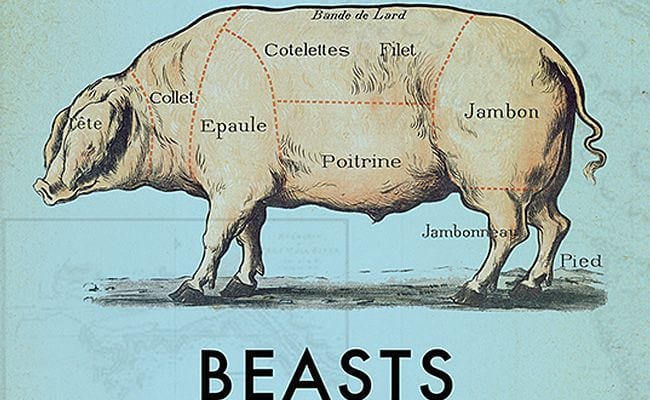
In Lesser Beasts, historian Mark Essig offers a compelling look at one of history’s most divisive animals: the pig. His curiosity was piqued after moving to North Carolina’s mountains, where pig drovers once herded pigs from Tennessee into South Carolina and Georgia. There the animals became cheap feed for plantation slaves.
Sus scrofa and homo sapiens share surprising similarities. Both have simple digestive tracts and full sets of all-purpose teeth. Cows, by comparison, have complex, multi-chambered stomachs permitting cellulose digestion. Why is this important? Complicated digestion requires more calories. Simple stomachs do not, freeing those calories for other activities, among them intellectual development. Pigs are smart. Really smart. Essig calls them “arrogant bastards” who, like their fellow arrogant bastard humans, enjoy sitting around, drinking beer, and watching television.
Contrary to popular belief, humans did not domesticate pigs. Rather, pigs began hanging around humans, first. Pig bones found at Hallan Cemi, an 11,000 year old Turkish archaeological site, explain much about early pigs and man. Hallan Cemi villagers were hunter-gatherers. But they ate male pigs while keeping females alive for breeding purposes. The pigs, therefore, were a bridge from hunting and gathering to agriculture.
But the Hallan Cemi pigs and their fellow porkers around Eurasia were more than dinner. In the days before weekly garbage pickup, their omnivorousness performed a welcome civic duty. By eating whatever garbage humans produced—spoiled food, human waste, rotted grain–pigs kept settlements clean. But their very omnivorousness also made them contentious. As human and porcine populations increased, so did prohibitions against pigs. Most notable was Judaism’s biblical injunction against eating pork. Essig writes: “There are many theories regarding why the Jews formally prohibited pork.”
That’s putting it mildly. Among the numerous theories out there: early Israelites didn’t want to compete with pigs for scarce grain. The disgusting porcine diet made human consumption untenable. Pigs were a ready source of meat for the poor, and the poor needed to be controlled. Prohibiting pork consumption was a way to do that. But in the end, apart from Biblical injunction, nobody knows why Jews are forbidden pork.
By 1200 B.C., Essig writes: “Near East elites had begun to see pigs as polluting”, a perception persisting amongst many this day. Yet as Jews and Muslims refused pork, the Romans, Goths, Anglo-Saxons, and their European descendants wholeheartedly embraced it. Medieval cooks began salt-curing to preserve pork, discovering a process so delicious that two millennia later, it remains popular amongst the farm-to-table set.
European colonists brought pigs to North America. By eating their way through Native American food sources, pigs gave colonists an unwitting hand in decimating Native populations. Pigs ate the grasses Native Americans relied on for weaving. They rooted up Native American grain caches and ate them. Pigs along the eastern shoreline destroyed clam and oyster populations. In Oregon’s Willamette Valley, pigs ate the marsh lily Native Americans relied on for sustenance. The Natives starved.
The final portion of Lesser Beasts examines the rise of modern pork processing. Pork producers cared nothing for public health, sanitation, animal welfare or worker well-being. Instead, in large plants, humans and pigs alike were subject to appalling conditions on rapidly moving production lines. It wasn’t until Upton Sinclair’s The Jungle, written in 1906, that the public learned their dinner was dosed with borax and dirt, salvia and sawdust. Pork consumption plummeted. Two wars and the Great Depression did pork-eating no favors: chicken and beef soon eclipsed the pig.
In 1985, the National Pork Producers Association rolled out “The Other White Meat”, an ad campaign equating pork to chicken—low fat and healthy, unlike the fatty, indigestible meat of yore. Indeed, pork producers were encouraged to breed lean animals using the latest and greatest technology: antibiotics, feed, and supplements.
Essig’s description of factory farming conditions is queasy reading: pigs are confined in 2’x7′ crates, on slatted flooring over concrete. They are kept in the dark, in buildings so poorly ventilated that entering humans must don masks. The pollution generated from pig manure is hazardous to pigs and humans alike; open cesspools have contaminated groundwater, caused fires, and killed fish. “Manure lagoons” are so foul that one man living nearby said: “We are used farm odors. These are not farm odors. “
Pigs in these conditions are unable to express inborn behaviors like nesting, nuzzling, or rooting. Distressed, they gnaw the bars of their stalls until their mouths are bloody.
Pigs need straw. They need to wallow, to lie down, to build nests for their piglets. Some American farms are turning away from factory farming; Essig cites Niman Ranch. I would add Becker Lane Organic. Humanely-raised pork is more expensive, but that isn’t a problem for buyers Essig calls “virtuous carnivores”. These consumers are concerned with animal welfare, the planet, and their own health. Virtuous carnivores comprise a tiny segment of the food purchasing public, but hope their numbers will increase. If nothing else, it will bring meat costs down.
Informative, surprising, and often sad, Lesser Beasts says a great deal about our often uneasy relationship to the planet and the animals inhabiting it. If we choose to eat animals, how do we rest easily with that decision? Can we rest easily with decision? Should we? Even if we choose vegetarianism, we still must share a shrinking, ever-hotter planet. Lesser Beasts asks us to consider how. And how we decide to treat pigs is how we decide to treat other animals, too—including each other.
